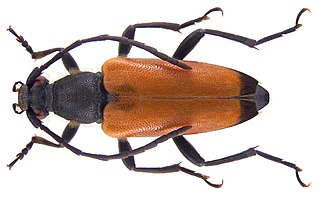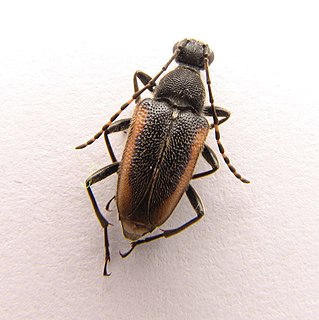
The longhorn beetles are a cosmopolitan family of beetles, typically characterized by extremely long antennae, which are often as long as or longer than the beetle's body. In various members of the family, however, the antennae are quite short and such species can be difficult to distinguish from related beetle families such as the Chrysomelidae. The family is large, with over 26,000 species described, slightly more than half from the Eastern Hemisphere. Several are serious pests. The larvae, called roundheaded borers, bore into wood, where they can cause extensive damage to either living trees or untreated lumber. A number of species mimic ants, bees, and wasps, though a majority of species are cryptically colored. The rare titan beetle from northeastern South America is often considered the largest insect, with a maximum known body length of just over 16.7 cm (6.6 in). The scientific name of this beetle family goes back to a figure from Greek mythology: after an argument with nymphs, the shepherd Cerambus was transformed into a large beetle with horns.

The Chrysomeloidea are an enormous superfamily of beetles, with tens of thousands of species, mostly in the families Cerambycidae and Chrysomelidae, the leaf beetles.

Lamiinae, commonly called flat-faced longhorns, are a subfamily of the longhorn beetle family (Cerambycidae). The subfamily includes over 750 genera, rivaled in diversity within the family only by the subfamily Cerambycinae.

The Disteniidae are a small family of beetles in the superfamily Chrysomeloidea, traditionally treated as a group within the Cerambycidae.

The Oxypeltidae are a small family belonging to the superfamily Chrysomeloidea, widespread in the Andean region of Chile and Argentina. They have traditionally been considered a group within the Cerambycidae.

Cerambycinae is a subfamily of the longhorn beetle family (Cerambycidae). The subfamily includes over 715 genera, which, in total, consist of some 3,900 species. The subfamily is most widely distributed in the Americas, with 430 species in 130 genera in its neotropical regions. Within the family, the only subfamily of comparable diversity is the Lamiinae.

Lepturinae, the lepturine beetles, is a subfamily of the longhorn beetle family (Cerambycidae), containing about 150 genera worldwide. This lineage is most diverse in the Northern Hemisphere. Until recently the subfamily Necydalinae was included within the lepturines, but this has been recently recognized as a separate subfamily. Nine tribes are usually recognized today, with a tenth, Caraphiini, created in 2016. A few genera are of uncertain placement within the subfamily.

Pseudomorpha is a genus of beetles in the family Carabidae, containing the following species:

Brachyleptura fulva is a species of longhorn beetle in the Lamiinae subfamily that can be found in Crimea and France. The colour of the species is black, with orange wings.
Batesiata tesserula is a species of longhorn beetle in the Lepturinae subfamily. It was described by Toussaint de Charpentier in 1825 and is found in Albania, Bulgaria, Czech Republic, Greece, Iran, Montenegro, Poland, Romania, Serbia, Slovakia, Turkey, and Ukraine. The females have much smaller prothorax than males. The species are black coloured with orange wings, that have a black dot on each of them. This is the only way to distinguish it from Brachyleptura fulva.

Brachyleptura is a genus of beetles in the family Cerambycidae, containing the following eight species:

Trachyderini is a tribe of long-horned beetles in the family Cerambycidae. There are at least 140 genera and 650 described species in Trachyderini.
Brachyleptura circumdata is a species of beetle in the family Cerambycidae. It was described by Olivier in 1795.
Brachyleptura dehiscens is a species of beetle in the family Cerambycidae. It was described by John Lawrence LeConte in 1859.
Brachyleptura pernigra is a species of beetle in the family Cerambycidae. It was described by Linell in 1897.

Brachyleptura rubrica is a species of beetle in the family Cerambycidae. It was described by Thomas Say in 1824. It feeds on various Spiraea species.
Brachyleptura vagans is a species of beetle in the family Cerambycidae. It was described by Olivier in 1795.
Brachyleptura vexatrix is a species of beetle in the family Cerambycidae. It was described by Mannerheim in 1853.
Dmytro Zajciw was a Ukrainian and Brazilian entomologist, notable for his collection and for his many beetle discoveries. He was the author of Two new genera and species of neotropical Longhorn beetles , 1957, Contribution to the study of Longhorn beetles of Rio de Janeiro , 1958, and was the first to describe the genera Adesmoides and Pseudogrammopsis, as well as the species Beraba angusticollis and Mionochroma subaurosum, among many others.













